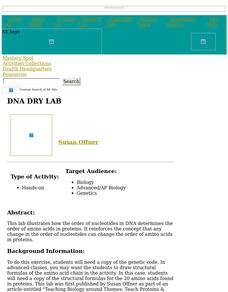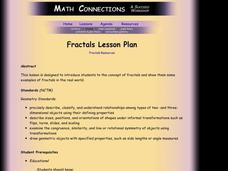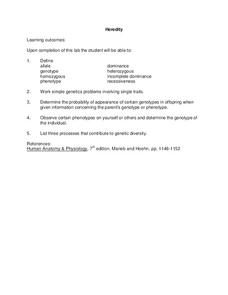Curated OER
How Cells Duplicate and Why Where Something Can Go Wrong
Seventh graders explore the function of a cell and cell division. In this investigative lesson students construct a 3-D model of a DNA molecule.
Curated OER
DNA Dry Lab
Learners use a DNA strand to identify the component parts. They discuss an RNA molecule, protein fragments, and nucleotides. They explore how the order of nucleotides determines the order of amino acids in proteins.
Curated OER
Hierarchical Organization in Biology: Students Presentations of Neurobiology
Students gather (research) information on neuron structure and action potential. Students are guided to make inferences about the synapse and its relationship to neurotransmitter release and action. They are also guided to make...
Curated OER
Passive in Context
In this tense worksheet, students read the sentences or phrases and choose which tense they are written in. Students complete 10 problems total.
Curated OER
The Challenge to Deliver Insulin
Learners investigate these fundamental chemical and cellular processes. They recognize the long-term danger that comes from a diet of fast food, chips, and soda, realize that avoiding diabetes is their responsibility, and establish...
Curated OER
Fractals
Learners explore the concept of fractals. In this fractal lesson, students use applets to explore Koch's Snowflake, Sierpinski's Triangle, and other fractals. Learners develop these concepts through exploration and teacher guided...
Curated OER
Amylase Enzyme In Saliva
Students test for amaylase enzyme in a variety of substances. Student pairs perform a series of tests to determine how long it takes the starch sample to change to sugar molecules and the blue color to disappear when various saliva...
Curated OER
DNA and RNA Exercises
In this protein synthesis worksheet, students answer 14 short answer questions about the process of making proteins from DNA.
Curated OER
Ionic Compounds
In this ionic compounds worksheet, students identify the number of electrons gained or lost in ions, they show that transfer of electrons in ionic compounds and they write balanced ionic compounds given ions. They answer 4 questions...
Curated OER
SAT Sentence Completion Practice Test 03
In this sentence completion learning exercise, students choose the answer that best completes each sentence. Students have 10 minutes to complete 12 sentences in this SAT practice learning exercise.
Curated OER
DNA. RNA, and Proteins
A comprehensive five-page quiz or study guide covering DNA and its related processes. Young geneticists will need a strong understanding in order to complete this handout, which includes multiple choice, matching, compare/contrast, and...
Curated OER
Mendelian and Non-Mendelian Heredity
Tenth graders discuss their physical features, and why they look the way they do. They listen as the teacher discusses DNA, alleles, and dominant or recessive genes. Students perform an experiment with different colored markers...
Curated OER
And the Verdict Is...
Young scholars identify the unique pattern DNA forms in each individual, and how that pattern can be used to identify criminals. They have the opportunity to simulate the process of matching DNA samples to those taken at a crime scene.
Curated OER
Animals and Humans Say the Darnedest Things
Students explore and analyze human and animal communications and create a short film that illustrates their findings.
Curated OER
Heredity
In this science worksheet, students find the answers to various types of heredity problems. They use the sheet to set goals for completing the unit.
Curated OER
DNA the Easy Way (and "Gram Stain" Without the Mess)
Learners visualize DNA from cells and explain the basis and importance of the Gram-stain reaction and to perform the KOH test equivalent.
Curated OER
Biodiversity - Who Cares?
Students articulate some of the impacts of loss of biodiversity. They play a game that demonstrates why having a rich variety of life is important to the survival of ecosystems and how invasive species are threatening local biodiversity.
Curated OER
Ethical Decision Making in Biology
Students explore a model that illustrates the spread of HIV through an adolescent population. Acting in the role of epidemiologists, students explore the dilemmas of HIV infection presented by a simulation. Students produce a play, skit,...
Curated OER
Who Stole My Salad?
Eighth graders explain how protein is made in the cell. In this biology lesson, 8th graders translate RNA and DNA using an internet database. They determine the thief based on evidence collected.
Curated OER
Issues in Genomics
Students explore the definition of ethics and genomics. In this organism lesson plan students participate in the chosen teacher lesson plan.
Curated OER
Breaking News English: Laboratory-Created Eggs and Sperm
In this English worksheet, students read "Laboratory-Created Eggs and Sperm," and then respond to 47 fill in the blank, 7 short answer, 20 matching, and 8 true or false questions about the selection.
Curated OER
Scientific Advances Could Bring Back the Dodo & Mammoth
Learners reflect on the possibility of bringing extinct species back to life. In this ESL lesson, students debate the pros and cons of extinction reversal then complete several activities centered around the topic.
Curated OER
Biotechnology
In this biology worksheet, learners complete a crossword puzzle with 23 questions on biotechnology. They identify the benefits and ethical issues about biotechnology.
Curated OER
Using Blood Tests to Identify Babies and Criminals
Students solve a crime by matching a suspect's blood type to physical evidence collected at the crime scene. In this forensic science lesson, students identify the different blood types. They explain how blood tests work.
Other popular searches
- Cracking the Genetic Code
- Using the Genetic Code
- Genetic Code Proteins
- Genetic Code Sequencing
- Middle School, Genetic Code
- Middle School Genetic Code
- Genetic Code Worksheets
- The Genetic Code

























